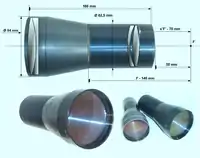Petzval lens
The Petzval objective or Petzval lens is the first photographic portrait objective lens (with a 160mm focal length) in the history of photography.[1] It was developed by the German-Hungarian mathematics professor Joseph Petzval in 1840 in Vienna,[2] with technical advice provided by Peter Wilhelm Friedrich von Voigtländer. The Voigtländer company went on to build the first Petzval lens in 1840 on behalf of Petzval, whereupon it became known throughout Europe.[2] Later, the optical instruments maker Carl Dietzler in Vienna also produced the Petzval lens.[2]

History
The Voigtländer-Petzval objective lens was revolutionary and attracted the attention of the scientific world because it was the first mathematically calculated precision objective in the history of photography. Petzval's lens established two new features: firstly, it was faster compared to previous lenses, with a maximum aperture of 1:3.6. In comparison to Daguerre's daguerreotype camera lens of 1839, Petzval's design had 22 times the light-gathering capacity, which for the first time enabled portraits under favourable conditions with exposure times of less than a minute.
Additionally, Petzval calculated for the first time the composition of the lenses based on optical laws, whereas optics before had previously been ground and polished according to experience. For the calculations, 8 artillery gunners and 3 corporals were made available to Petzval by Archduke Louis of Austria (commander of the artillery), since the artillery was one of the few professions where mathematical calculations were made.
By 1845 Petzval's collaboration with Voigtländer, who held the license to produce the lenses, had become "mired in disputes'. Voigtländer moved production outside of Austria and therefore beyond Petzval’s patent limitations.[3] The Petzval objective was produced by Voigtländer and sold worldwide; until 1862 Voigtländer had produced 60,000 pieces.
One disadvantage of Petzval's design was a sharp drop in sharpness at the edges, which was corrected in the Aplanat lens developed by Hugo Adolph Steinheil.
Optical Design
The lens consisted of two doublet lenses with an aperture stop in between. The front lens is well corrected for spherical aberrations but introduces coma. The second doublet corrects for this and the position of the stop corrects most of the astigmatism. However, this results in additional field curvature and vignetting. The total field of view is therefore restricted to about 30 degrees. An f-number of f/3.6 was achievable, which was considerably faster than other lenses of the time.
Lens revival
In 2013 Lomography successfully launched a crowdfunding campaign at kickstarter.com to produce a new Petzval lens in Russia for film and digital cameras.[4]
Lensbaby offers Petzval lenses for modern cameras under the Burnside and Twist names.[5]
William Optics produces a 51 mm F/4.9 (250 mm focal length) Petzval lens for astrophotography.[6]
Image gallery
 Cross section view of Petzval objectives: Portrait objective (German Porträtobjektiv) and ocular lens (German Orthoskop).
Cross section view of Petzval objectives: Portrait objective (German Porträtobjektiv) and ocular lens (German Orthoskop). An example of a portrait photo (of Katherine Maher) taken with a Lomography produced Petzval lens. Note the unique 'swirly' bokeh.
An example of a portrait photo (of Katherine Maher) taken with a Lomography produced Petzval lens. Note the unique 'swirly' bokeh. Petzval type movie projection lens
Petzval type movie projection lens
References
| Wikimedia Commons has media related to Petzval lenses. |
Ray, Sidney (2002). Applied Photographic Optics. Oxford, UK: Focal Press. ISBN 0-240-51540-4.
- US Grant US2500046 A, Willy Schade, "Petzval-type photographic objective", published 7 March 1950, assigned to Eastman Kodak Co.
- Day, Lance; McNeil, Ian (1996). Biographical Dictionary of the History of Technology. London: Routledge. pp. 958–959. ISBN 0415060427.
- Szatucsek, Zoltán; Taes, Sofie (September 2019). "Optical innovation: how the Petzval lens revolutionised portrait photography". Europeana (CC By-SA). Retrieved 2019-10-09.
- Kickstarter
- "RedCat 51 APO F/4.9".